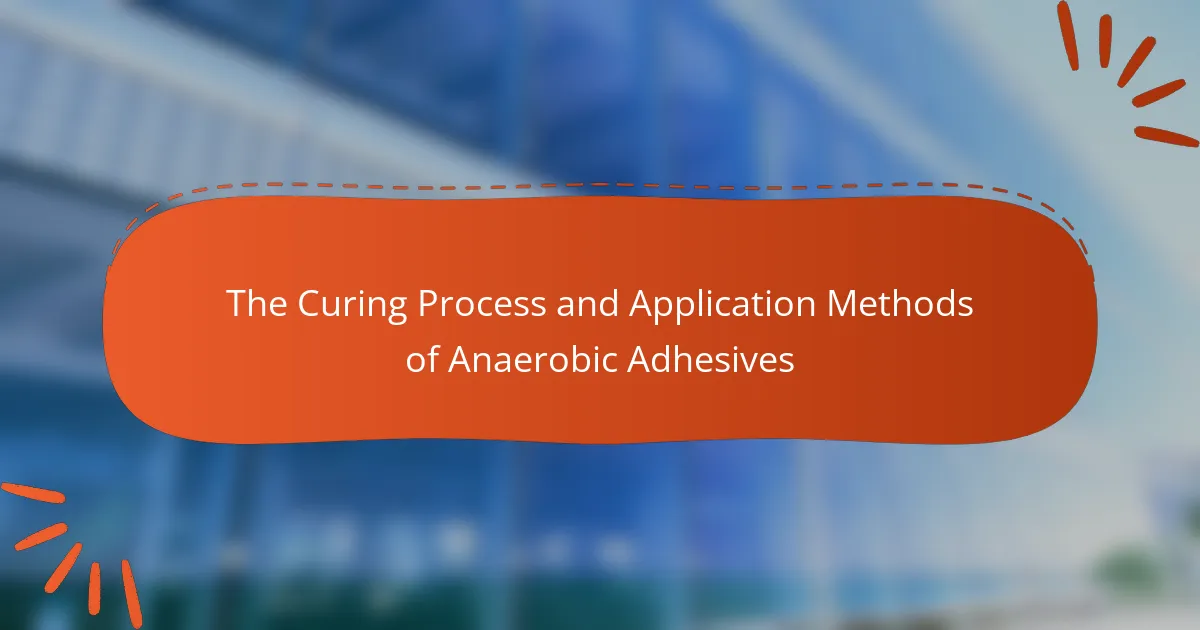Silicone adhesives are bonding agents composed of silicone polymers, recognized for their strong adhesion to materials such as glass, metal, and plastics. They maintain flexibility after curing, allowing them to adapt to movement and temperature fluctuations, while also exhibiting resistance to moisture and chemicals. Common applications include sealing joints in construction, bonding automotive parts, and creating waterproof seals in electronics. The article explores the chemical resistance of silicone adhesives, detailing their ability to withstand exposure to various chemicals, including oils, solvents, and acids, and providing guidance on selecting the appropriate adhesive based on specific chemical interactions and environmental conditions.
![]()
What are Silicone Adhesives and Their Uses?
Silicone adhesives are versatile bonding agents made from silicone polymers. They are known for their strong adhesion to a variety of materials, including glass, metal, and plastics. Silicone adhesives remain flexible after curing, allowing them to withstand movement and temperature changes. Their resistance to moisture and chemicals makes them suitable for both indoor and outdoor applications. Common uses include sealing joints in construction, bonding automotive parts, and creating waterproof seals in electronics. The ability to withstand extreme temperatures, from -60°C to 200°C, enhances their utility in diverse environments.
How do Silicone Adhesives differ from other types of adhesives?
Silicone adhesives differ from other types of adhesives primarily due to their unique chemical composition. They are made from silicone polymers, which provide excellent flexibility and temperature resistance. Unlike epoxy or polyurethane adhesives, silicone adhesives maintain their properties in extreme temperatures, ranging from -60°C to 200°C. Additionally, silicone adhesives exhibit superior resistance to moisture and UV light. This makes them ideal for outdoor applications. Other adhesives may degrade under similar conditions. Silicone adhesives also have a longer lifespan, often lasting several decades without significant degradation. Their ability to bond with various substrates, including glass, metal, and plastics, further distinguishes them from other adhesive types.
What are the key characteristics of Silicone Adhesives?
Silicone adhesives are known for their unique properties. They exhibit excellent temperature resistance, functioning effectively in a range from -60°C to 200°C. Their flexibility allows for movement without compromising bond integrity. Silicone adhesives also provide strong adhesion to various substrates, including glass, metal, and plastics. They are resistant to moisture, UV light, and many chemicals, making them suitable for outdoor applications. Additionally, silicone adhesives maintain their performance over time without significant degradation. Their non-toxic nature makes them safe for various uses, including food contact applications.
In what applications are Silicone Adhesives commonly used?
Silicone adhesives are commonly used in construction, automotive, and electronics applications. In construction, they provide strong bonding for glass, metal, and plastic materials. Automotive industries utilize silicone adhesives for sealing and bonding components, ensuring durability and flexibility. In electronics, these adhesives are employed for encapsulating and protecting sensitive components. Their resistance to extreme temperatures and chemicals makes them ideal for these applications. Furthermore, silicone adhesives are also used in medical devices for their biocompatibility and reliability.
Why is Chemical Resistance important for Silicone Adhesives?
Chemical resistance is crucial for silicone adhesives to maintain their integrity in various environments. Silicone adhesives are often exposed to chemicals, solvents, and extreme temperatures. High chemical resistance ensures that these adhesives do not degrade or lose their bonding strength. This property prevents failures in applications such as automotive, aerospace, and construction. For instance, silicone adhesives can withstand exposure to oils and fuels without compromising their performance. Their resistance to harsh chemicals extends the lifespan of products and reduces maintenance costs. Therefore, chemical resistance is a key attribute that enhances the reliability and versatility of silicone adhesives.
What factors influence the chemical resistance of Silicone Adhesives?
The chemical resistance of silicone adhesives is influenced by their formulation, curing process, and the presence of fillers. Formulation determines the types of siloxane polymers used. Different siloxane structures can enhance or reduce chemical resistance. The curing process affects cross-linking density, which impacts durability. Higher cross-linking density generally improves resistance. Fillers can also modify the adhesive’s properties. Specific fillers may enhance resistance to certain chemicals. Environmental factors, such as temperature and humidity, further influence performance. Studies show that silicone adhesives can withstand a range of chemicals, but specific formulations are required for optimal resistance.
How does chemical exposure affect the performance of Silicone Adhesives?
Chemical exposure can significantly degrade the performance of silicone adhesives. Various chemicals can cause silicone to lose its adhesion properties. For instance, solvents can weaken the bond strength. This weakening can lead to premature failure in applications. Prolonged exposure to harsh chemicals may also result in physical changes. These changes include discoloration, brittleness, and loss of elasticity. Studies have shown that specific chemicals can lead to a reduction in tensile strength. For example, exposure to acetone may decrease adhesion performance by over 50%. Therefore, understanding chemical compatibility is crucial for optimal use of silicone adhesives.
![]()
What Types of Chemicals can Silicone Adhesives Resist?
Silicone adhesives can resist a variety of chemicals including oils, solvents, and acids. They are particularly effective against mineral oils and vegetable oils. Silicone adhesives also show resistance to many common solvents like isopropyl alcohol and acetone. Additionally, they can withstand exposure to weak acids and bases. This chemical resistance is due to the stable structure of silicone polymers. The ability to endure harsh environments makes silicone adhesives suitable for various applications. Their resilience is supported by their use in automotive, construction, and electronic industries.
What are the common categories of chemicals that Silicone Adhesives are tested against?
Silicone adhesives are commonly tested against several categories of chemicals. These include solvents, acids, bases, oils, and fuels. Solvents can degrade adhesive properties and affect bonding strength. Acids may cause corrosion or chemical breakdown. Bases can also impact the integrity of silicone adhesives. Oils and fuels are tested for resistance to degradation and swelling. Testing against these categories ensures the performance and longevity of silicone adhesives in various applications.
How do acids affect the performance of Silicone Adhesives?
Acids negatively impact the performance of silicone adhesives. They can cause degradation of the silicone polymer structure. This leads to a reduction in adhesion strength. Acids may also result in discoloration and loss of flexibility. The chemical reaction alters the physical properties of the adhesive. Studies indicate that exposure to strong acids can significantly shorten the lifespan of silicone adhesives. For instance, hydrochloric acid can lead to noticeable deterioration within days. Proper formulation and additives can enhance acid resistance, but limitations exist.
What is the impact of solvents on Silicone Adhesives?
Solvents can significantly affect silicone adhesives. They may cause swelling, degradation, or loss of adhesion. Silicone adhesives are generally resistant to many chemicals, but exposure to certain solvents can weaken their structural integrity. For instance, polar solvents like acetone can disrupt the silicone polymer chains. This disruption leads to a decrease in adhesive strength and flexibility. Research indicates that prolonged exposure to solvents can result in complete bond failure. Therefore, it is crucial to assess solvent compatibility when using silicone adhesives in applications.
What are the limitations of Silicone Adhesives in terms of chemical resistance?
Silicone adhesives have limitations in chemical resistance, particularly against certain solvents and acids. They generally resist water and mild chemicals well. However, strong acids, alkalis, and organic solvents can degrade their performance. For instance, silicone adhesives may swell or lose adhesion when exposed to fuels and oils. This degradation can compromise bond strength and integrity. Additionally, high temperatures can further weaken their chemical resistance. Studies indicate that prolonged exposure to harsh chemicals can lead to failure in applications.
What types of chemicals can degrade Silicone Adhesives?
Solvents and strong acids can degrade silicone adhesives. Common solvents include acetone, toluene, and methylene chloride. These solvents can break down the polymer structure of silicone. Strong acids like hydrochloric acid and sulfuric acid can also cause degradation. Exposure to these chemicals can weaken the adhesive’s bond. Research indicates that prolonged contact with such chemicals leads to significant loss of adhesion strength. The degradation process varies based on concentration and exposure time. These factors play a crucial role in the effectiveness of silicone adhesives in various environments.
How does temperature affect the chemical resistance of Silicone Adhesives?
Temperature significantly impacts the chemical resistance of silicone adhesives. Higher temperatures can reduce the viscosity of silicone adhesives, making them more susceptible to chemical degradation. This degradation occurs because elevated temperatures can accelerate chemical reactions, leading to a breakdown of the adhesive’s molecular structure. Conversely, lower temperatures can enhance the stability of silicone adhesives, improving their resistance to chemicals.
For example, a study published in the Journal of Applied Polymer Science showed that silicone adhesives maintained better chemical resistance at temperatures below 70°C. Beyond this threshold, the adhesive’s performance diminished due to thermal aging. Therefore, the temperature range in which silicone adhesives are used is critical for maintaining their chemical resistance.
![]()
How to Choose the Right Silicone Adhesive for Chemical Resistance?
To choose the right silicone adhesive for chemical resistance, assess the specific chemicals it will encounter. Identify the adhesive’s formulation, as different silicones offer varying resistance levels. Review the manufacturer’s technical data sheets for compatibility information. Consider the adhesive’s temperature range, as high temperatures can affect performance. Evaluate the curing time and conditions, which can influence the adhesive’s final properties. Test the adhesive in a small area to ensure it meets your requirements. Research industry standards for chemical resistance to validate your choice. This systematic approach ensures optimal performance in your application.
What factors should be considered when selecting a Silicone Adhesive?
When selecting a silicone adhesive, consider its chemical resistance, bonding strength, and curing time. Chemical resistance indicates how well the adhesive withstands exposure to various substances. Bonding strength determines the adhesive’s ability to hold materials together under stress. Curing time affects how quickly the adhesive sets and reaches full strength. Additionally, consider temperature resistance, flexibility, and application method. Temperature resistance indicates the adhesive’s performance in extreme conditions. Flexibility allows for movement between bonded surfaces without breaking. The application method influences ease of use and effectiveness.
How do specific application requirements influence the choice of Silicone Adhesive?
Specific application requirements significantly influence the choice of silicone adhesive. Factors such as temperature resistance, flexibility, and curing time dictate the selection process. For instance, high-temperature applications require silicone adhesives that can withstand extreme heat without losing adhesion. Similarly, applications needing flexibility benefit from silicone adhesives designed to maintain elasticity. The curing time is crucial for projects requiring quick assembly, leading to the selection of fast-curing silicone options. Additionally, the chemical environment of the application impacts the choice. Silicone adhesives are favored for their resistance to a variety of chemicals, making them suitable for industrial and automotive uses. Thus, understanding these requirements ensures optimal performance and durability of the adhesive in its intended application.
What tests can be conducted to evaluate the chemical resistance of Silicone Adhesives?
The tests that can be conducted to evaluate the chemical resistance of silicone adhesives include immersion tests, chemical exposure tests, and accelerated aging tests. Immersion tests involve submerging the adhesive in various chemicals for a specified duration. This helps determine how the adhesive reacts to specific substances. Chemical exposure tests assess the adhesive’s performance when exposed to different chemicals in controlled environments. Accelerated aging tests simulate long-term exposure to chemicals and environmental conditions to predict durability. These methods provide insights into the adhesive’s stability and integrity when subjected to chemical agents.
What are the best practices for using Silicone Adhesives in chemically challenging environments?
The best practices for using silicone adhesives in chemically challenging environments include selecting the appropriate silicone formulation for specific chemicals. Use high-performance silicone adhesives that offer enhanced resistance to solvents, acids, and bases. Surface preparation is crucial; ensure surfaces are clean, dry, and free of contaminants to enhance adhesion. Apply the adhesive in controlled conditions, avoiding extreme temperatures and humidity, which can affect curing. Allow adequate curing time, as silicone adhesives may require longer to achieve full strength in adverse conditions. Regularly test adhesion and performance in real-world conditions to ensure reliability. These practices help maximize the effectiveness and longevity of silicone adhesives in demanding applications.
Silicone adhesives are versatile bonding agents made from silicone polymers, renowned for their strong adhesion to various materials and resistance to moisture, chemicals, and extreme temperatures. This article explores the unique characteristics of silicone adhesives, including their chemical resistance, which is critical for maintaining integrity in diverse applications such as construction, automotive, and electronics. Key factors influencing their chemical resistance, common chemical exposures, and best practices for use in chemically challenging environments are also examined to ensure optimal performance and longevity.


